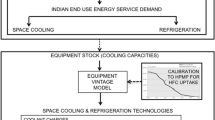Abstract
This paper presents the theoretical investigation of CDM opportunity in a township at Jaipur, India. The purpose of study is to identify and analyze the various opportunities viz., installation of solar water heater, energy efficient lighting, energy efficient air conditioners, and energy efficient submersible water pumps in desert coolers and thus achieve a considerable (65.7 %) reduction in GHG emissions. Out of the various opportunities considered, the retrofitting with solar water heater can be recommended for CDM. Though, the retrofitting with energy efficient lighting, energy efficient air conditioners and energy efficient submersible water pumps in desert coolers claimed CO2 emission reduction of 104.84, 25.92, and 36.94 tons per annum, respectively, but the only opportunity which got through CDM was retrofitting with solar water heater claiming 115.70 tCO2 (100 %) emission reductions per annum which could result into net earnings of 115.70 CERs. The simple and discounted payback period for all four project activities are also calculated with and without CDM and tax benefits.







Similar content being viewed by others
References
Agustin, J. L. B., & Lopez, R. D. (2006). Economic and environment analysis of grid connected photovoltaic systems in Spain. Renewable Energy, 31, 1107–1128.
Crawford, R. H., & Treloar, G. J. (2004). Net energy analysis of solar and conventional domestic hot water systems in Melbourne, Australia. Solar Energy, 76, 159–163.
Fenhann, J., Halsnaes, K., Pacudan, R., & Olhoff, A. (2004). CDM Information and Guidebook, Second edition, UNEP Riso Centre on Energy, Climate and Sustainable Development, Riso National Laboratory Roskilde, Denmark, ISBN: 87-550-3339-3.
Guan, F. M., Mills, E., & Qin, Z. (1997). Energy efficient lighting in China. Energy Policy, 25, 77–83.
Hens, H. (2010). Energy efficient retrofit of an end of the row house: confronting predictions with long-term measurements. Energy and Buildings, 42, 1939–1947.
Kalogirou, S. (2009). Thermal performance, economic and environmental life cycle analysis of thermosiphon solar water heaters. Solar Energy, 83, 39–48.
Kazakevicius, E., Gadgil, E., & Vorsatz, D. (1999). Residential lighting in Lithuania. Energy Policy, 27, 603–611.
Lee, A. H. W. (2000). Verification of electrical energy savings for lighting retrofits using short- and long-term monitoring. Energy Conversation and Management, 41, 1999–2008.
Mahlia, T. M. I., Masjuki, H. H., & Choudhury, I. A. (2002). Potential electricity savings by implementing energy labels for room air conditioner in Malaysia. Energy Conversion and Management, 43, 2225–2233.
Mahlia, T. M. I., Masjuki, H. H., Saidur, R., & Amalina, M. A. (2004). Mitigation of emissions through energy efficiency standards for room air conditioners in Malaysia. Energy Policy, 32, 1783–1787.
Mahlia, T. M. I., Said, M. F. M., Masjuki, H. H., & Tamjis, M. R. (2005). Cost-benefit analysis and emission reduction of lighting retrofits in residential sector. Energy and Buildings, 37, 573–578.
Mahlia, T. M. I., Abdul Razak, H., & Nursahida, M. A. (2011). Life cycle cost analysis and payback period of lighting retrofit at the University of Malaya. Renewable and Sustainable Energy Reviews, 15, 1125–1132.
Michaelowa, A., & Purohit, P. (2006). Additionality determination of Indian CDM projects: Can Indian CDM project developers outwit the CDM Executive Board, Draft Report, University of Zurich, Institute for Political Science, Műhlegasse 21, 8001 Zűrich, Switzerland.
Mizuno, Y. CDM in Charts, Version 9.0, November 2009, Institute for Global Environmental Strategies, Ministry of the Environment, Japan.
Pallav Purohit, P., & Michaelowa, A. (2008). CDM potential of SPV lighting systems in India. Mitigation and Adaptation Strategies for Global Change, 13, 23–46.
Shrestha R. M., Sharma, S., Timilsina, G. R., & Kumar, S. (2005) Baseline methodologies for Clean Development Mechanism Projects UNEP Riso Centre on Energy, Climate and Sustainable Development, Riso National Laboratory Roskilde, Denmark, ISBN: 87-550-3483-7.
Singh, I., & Michaelowa, A. (2004). Indian Urban Building Sector: CDM potential through energy efficiency in electricity consumption, HWWA Discussion Paper 289. Hamburg, Germany: Hamburg Institute of International Economics.
Stefano, J. D. (2000). Energy efficiency and the environment: the potential for energy efficient lighting to save energy and reduce carbon dioxide emissions at Melbourne University, Australia. Energy—The International Journal, 25, 823–839.
Techato, K., Watts, D. J., & Chaiprapat, S. (2009). Life cycle analysis of retrofitting with high energy efficiency air-conditioner and fluorescent lamp in existing buildings. Energy Policy, 37, 318–325.
The CO2 Baseline Database for the Indian Power Sector, Ministry of Power: Central Electricity Authority India (CEA), Version 5.0, November 2009. http://www.cea.nic.in/planning/c%20and%20e/Government%20of%20India%20website.htm
Tiwari, G. N. (2006). Solar energy fundamentals, design, modeling and applications (1st ed., pp. 452–487). New Delhi: Narosa Pub. House.
Tsilingiridis, G., Martinopoulos, G., & Kyriakis, N. (2004). Life cycle environmental impact of a thermosyphonic domestic solar hot water system in comparison with electrical and gas water heating. Renewable Energy, 29, 1277–1288.
UNFCCC, Tool for the demonstration and assessment of additionality. Version 5.2, 26th August 2008. http://cdm.unfccc.int/methodologies/PAmethodologies/approved.html
UNFCCC, Approved small scale methodology AMS I.C. Thermal energy for the user with or without electricity. Version 16, 4th December 2009. http://cdm.unfccc.int/methodologies/SSCmethodologies/approved.html
UNFCCC, Approved small scale methodology AMS II.C. Demand-side energy efficiency activities for specific technologies. Version 13, 17th July 2009. http://cdm.unfccc.int/methodologies/SSCmethodologies/approved.html
UNFCCC, Approved small scale methodology AMS I.D. Grid connected renewable electricity generation. Version 15, 16th October 2009 http://cdm.unfccc.int/methodologies/SSCmethodologies/approved.html.
Author information
Authors and Affiliations
Corresponding author
Rights and permissions
About this article
Cite this article
Misra, R., Aseri, T.K., Jamuwa, D.K. et al. Assessment of CO2 emission reduction and identification of CDM potential in a township. Energy Efficiency 5, 471–481 (2012). https://doi.org/10.1007/s12053-012-9156-8
Received:
Accepted:
Published:
Issue Date:
DOI: https://doi.org/10.1007/s12053-012-9156-8




